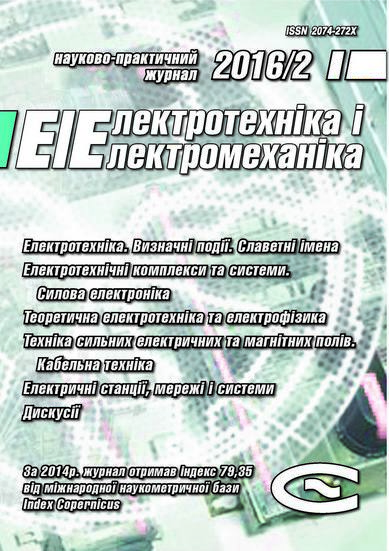A NEW HYPOTHESIS AND PHYSICAL BASES OF ORIGIN OF ROSARY LIGHTNING IN THE ATMOSPHERE OF EARTH
DOI:
https://doi.org/10.20998/2074-272X.2016.2.05Keywords:
linear lightning, rosary lightning, physical bases, plasma channel of a storm discharge, drifting lone electrons, electronic wavepackages, «hot» («light») and «cold» («dark») longitudinal areas of electronic wavepackages of channel of a storm dischargeAbstract
Purpose. Development and scientific ground of new hypothesis of origin of rosary lightning (RL) is in the air atmosphere of Earth. Methodology. Electrophysics bases of technique of high (ever-higher) impulsive voltage and large (weak) impulsive currents, and also theoretical bases of quantum physics. Results. The substantive provisions of new hypothesis of origin are formulated RL. Taking into account these positions bases of close electrophysics theory of origin are developed in an air atmosphere RL. Basic electrophysics terms, resulting in the transition of linear lightning (LL) in RL, are indicated. Originality. First on the basis of conformities to the law of quantum physics the new electrophysics mechanism of education is offered RL from LL. It is set that this mechanism the wave longitudinal distributing of drifting lone electrons is underlaid in the plasma cylindrical channel of a long spark storm digit in an air atmosphere, resulting in forming in him of «light» («hot») and «dark» («cold») longitudinal areas of periodic electronic wavepackages (EWP). It is shown that for LL information the areas of EWP periodically up-diffused along the channel of lightning are characterized the small and unnoticeable for observers lengths, and for RL − by large lengths and by sight noticeable for observers from earth. Practical value. Deepening of scientific knowledges about physics of such global atmospheric phenomenon as lightning. Expansion of scientific presentations of humanity about circumferential tellurians nature and difficult natural physical processes, flowings in it.
References
1. Yuman M.A. Molniya [Lightning]. Moscow, Mir Publ., 1972. 327 p. (Rus).
2. Bazelyan E.M., Horin B.N., Levitov V.I. Fizicheskye i inzhenernуе osnovу molniezashchitу [Physical and engineering bases lightning protection]. Leningrad, Gidrometeoizdat Publ., 1978. 223 p. (Rus).
3. Bazelyan E.M, Raiser Yu.P. Fizyka molnii i molnyezashchita [The physics of lightning and lightning protection]. Moscow, Fizmatlit Publ., 2001. 319 p. (Rus).
4. Kuzhekin I.P., Larionov V.P., Prokhorov E.N. Molniya i molnyezashchita [Lightning and lightning protection]. Moscow, Znak Publ., 2003. 330 p. (Rus).
5. Kravchenko V.I. Molniya. Elektromahnitny faktory i porazhayushchie vozdeystviya na tekhnycheskie sredstva [Lightning. Electromagnetic factors and their impact on the striking technical objects]. Kharkov, NTMT Publ., 2010. 292 p. (Rus).
6. Barry J. Sharovaya molniya y chetochnaya molniya [Ball lightning and rosary lightning]. Moscow, Mir Publ., 1983, 288 p. (Rus).
7. Baranov M.I., Koliushko G.M., Kravchenko V.I., Nedzel’skii O.S., Dnyshchenko V.N. A Current Generator of the Artificial Lightning for Full-Scale Tests of Engineering Objects. Pribory i tehnika eksperimenta − Instruments and Experimental Technique, 2008, no.3, pp. 401-405. doi: 10.1134/s0020441208030123.
8. Baranov M.I. Izbrannye voprosy elektrofiziki. Tom 2, Kn. 2: Teoriia elektrofizicheskikh effektov i zadach [Selected topics of Electrophysics. Vol.2, Book 2. A theory of electrophysical effects and tasks]. Kharkiv, NTU «KhPІ» Publ., 2010. 407 p. (Rus).
9. Raiser Yu.P. Fizika gazovogo razryada [Physics of gas discharge]. Moscow, Nauka Publ., 1987. 592 p. (Rus).
10. Bol'shoj illjustrirovannyj slovar' inostrannyh slov [Large illustrated dictionary of foreign words]. Moscow, Russkie slovari Publ., 2004. 957 p. (Rus).
11. Baranov M.I. Izbrannye voprosy elektrofiziki: Monografija v 2-h tomah. Tom 2, Kn. 1: Teorija elektrofizicheskih effektov i zadach [Selected topics of Electrophysics: Monograph in 2 vols. Vol. 2, book. 1: Theory of electrophysics effects and tasks]. Kharkov, NTU «KhPI» Publ., 2009. 384 p. (Rus).
12. Kuz'michev V.E. Zakony i formuly fiziki [Laws and formulas of physics]. Kiev, Naukova Dumka Publ., 1989. 864 p. (Rus).
13. Baranov M.I. Features heating thin bimetallic conductor large pulse current. Elektrichestvo – Electricity, 2014, no.4, pp. 34-42. (Rus).
14. Sobolev N.N. The study of electrical explosion of thin wires. Zhurnal eksperimental'noy i teoreticheskoy fiziki – Journal of experimental and theoretical physics, 1947, Vol.17, no.11, pp. 986-997. (Rus).
15. Baranov M.I. Phenomenon of physical fields distributing on the exponential law in nature and educa-tional process. Elektrotekhnіka і elektromekhanіka − Electrical engineering & electromechanics, 2004, no.3, pp. 111-115. (Rus).
Downloads
Published
How to Cite
Issue
Section
License
Copyright (c) 2016 M. I. Baranov

This work is licensed under a Creative Commons Attribution-NonCommercial 4.0 International License.
Authors who publish with this journal agree to the following terms:
1. Authors retain copyright and grant the journal right of first publication with the work simultaneously licensed under a Creative Commons Attribution License that allows others to share the work with an acknowledgement of the work's authorship and initial publication in this journal.
2. Authors are able to enter into separate, additional contractual arrangements for the non-exclusive distribution of the journal's published version of the work (e.g., post it to an institutional repository or publish it in a book), with an acknowledgement of its initial publication in this journal.
3. Authors are permitted and encouraged to post their work online (e.g., in institutional repositories or on their website) prior to and during the submission process, as it can lead to productive exchanges, as well as earlier and greater citation of published work.





